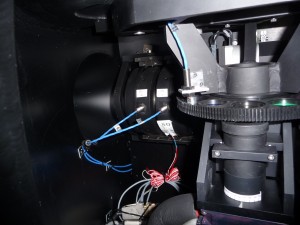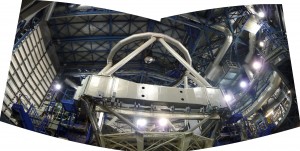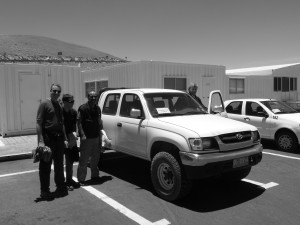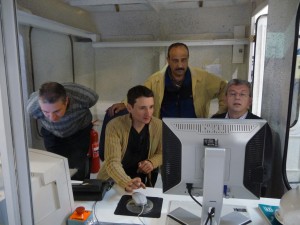X-Shooter on sky again (Day 2)

X-Shooter goes on sky again (Day 0 and 1)
January 16, 2009
X-Shooter goes on sky again (Night 1)
January 18, 2009This morning I woke up thinking I was still in my bed in the old, cold Europe. But no. I could hear the wind blowing and the taste of dry air in my mouth and all of a sudden I realized where I was. I looked at my watch. Mmm, it’s much earlier than I would have hoped, it is just ten, Chilean time… I pull out my laptop and start reading the email. Lots of them. I’ll take care of them later on. I write to Joel and after a few minutes ha answers. He is ready for a coffee. All right, then, I’ll join him, so that we can discuss about tonight’s plans.
On my way to the canteen I find him at the reception. He is on the phone with Hans, who is on the summit, running tests with the two Paolos. They want to verify whether the mechanics and electronics that drive the atmospheric dispersion correctors (ADC) for the UV and Visual arms work fine. These devices are very important, since they counterbalance the effect introduced by Earth’s atmosphere, which acts as a spectrograph. In fact, it disperses the light coming form an astronomical object, with at dispersion that increases as one goes away from zenith. The ADCs make sure that this effect is minimized, so that most of the light reaching the telescope from the faint astronomical sources actually makes into the small aperture window that leads into the spectrograph.

One of the ADCs of X-Shooter (left). The geared wheel on the right holds the filters for the imaging camera.
I had never seen an ADC of this type before. It is composed by two optical systems, each of them able to rotate under the action of an electronically controlled motor. According to the position where the telescope is pointing to, a dedicated software computes the appropriate rotation angle to compensate for the atmospheric dispersion. Then, as the telescope tracks the sidereal motion, the controlling software keeps moving very slowly the two optical systems while the detector collects the final spectrum. For this to work properly, it is crucial to know exactly the position of the rotating optics and their mutual orientation. This is why Paolo, Hans and Paolo are so busy this morning.
After a coffee, Joel starts planning for the upcoming night. After a few minutes Elena joins us and we discuss about the tests we will be running tonight. All right – I think – the thing starts to be real, now. Besides the ADCs, we want to test off-axis rotation and the automatic flexure correction. Then we need to take some deep night sky observations to check the quality of the background subtraction performed by the data reduction system. In fact, even though there are no traces of light pollution at Paranal (which by the way is one of the darkest spots on Earth) the sky naturally glows at night. This is because the upper layers of the atmosphere, say between 100 and 350 km, excited by the solar radiation, release the energy they have accumulated during the day emitting light. This is indeed weak and difficult to see with the naked eye. Nevertheless, many of the targets observed by the VLT are much, much fainter than the night sky itself. The only way ground-based astronomers have to get rid of it is to subtract it from their digital data. For doing this properly, one needs to trace its spectrum to a high level of accuracy and to have a software that properly deals with it.
We also have to observe a Sun-like star to test the spectrum extraction. All of this will keep us busy for the whole night. But first of all, we will have to see how the instrument behaves after the two months in which it remained dormant.
Time runs fast and we realize that the morning is over. Lunch time with Chilean specialties!
The two Paolos and Hans join us for lunch. The atmosphere is cheerful and there is lots of optimism, for things are running very smoothly. After another coffee (I admit I have put some ice-cream into mine…) we go up again to the telescope. It is time to see what the ADC test they left running has produced.

A composite image of UT3 Melipal. The thing is so big that I need to stitch two photos together to show it all.
Entering the dome of one of the UTs is always an impressive experience. The machine is just huge. Nevertheless, the motors move its 400 tons with an incredible accuracy. The secondary mirror, 1.2m in diameter, is larger than the primary mirror of many telescopes around the world… After watching the Moon with the 6×30 German binoculars of my father (geee, that must have been 1975…), the first really astronomical observation I ever made was through a 20 cm Newton telescope, built by an old amateur in my village, who also grinded and polished the mirror. It had an Alt-Az mount too (!), no finder scope and one single eyepiece, giving some 130x. I remember I spent half a night trying to get M31 into the field of view. Pointing was indeed an issue there… And now I’m here, admiring the 8.2m thin, monolithic mirror of the VLT. I still can’t believe it.
I am brought back from my reverie by Hans who, after extracting his head from one of the inspection windows of X-Shooter, tells us that the test went perfectly fine and the ADC positioning behaves as expected. Now it is time to check the phasing of the two ADCs. Sure, because it is not sufficient to be able to rotate the two optical systems. Their relative positioning is also important and this needs to be checked with a special test. Hans disappears, looking for a fluorescent lamp, while Joel grabs his laptop, where he has some software that will tell us whether things are right or not.
Once Hans is back with the lamp and he has properly installed it within the open instrument, the test starts. It takes some time, but after a while it is clear that things are as they should be. So, after closing the instrument, removing toolboxes and ladders, closing the electronics cabinets, we can go back to the VLT control room, where we will be running the observations tonight. This is going to be very interesting, under several aspects. For instance, at some point during the night, there will be a live connection with Paris, where the opening ceremony for the International Year of Astronomy is going to take place.
Before going down for dinner, we start a series of daytime calibrations, which will be used later on when we will analyze the data in more detail. Meanwhile Elena is preparing the configuration files for the night (we call them Observing Blocks). For any given observation, they contain all the information needed to preset the telescope and to set-up the instrument. In this way, to start an observation during the night, we will just have to select a file name from a pull-down menu and click a button. This will prevent us from doing mistakes, especially at four in the morning, when we will be not exactly fresh ;-).
Everything seems to be ready for the night. We still have a couple of hours before the sun sets and so we decide to spend the remaining time in what, in this moment, seems to be the most convenient thing to do. Going down to the residencia for dinner.
Hans, Joel and myself sit on the outside, facing the sunset. I am having a very nice sopa de mariscos, and I enjoy it very much, watching the sun sink below the horizon. The colors are gorgeous and the atmosphere is still. It is the nicest hour of the day. All of a sudden Joel claims he has seen a green flash. Indeed, I also see a greenish thing and I pull out my camera to take some pictures (afterwards they will turn out to be not that convincing…). Hans too confirms what we see. Well, yes, the green flash is a typical chimera that sooner or later you wish to declare you have seen. So, when we enthusiastically tell Elena about our positive detection, she looks at us rather skeptically… ok, ok, Elena, it will be next time, then.
The time to pick up a few things in my room and off we go, up to the summit. This is always a magic moment at Paranal, just before the night starts. The shadow of the Earth climbs the eastern sky and Venus shines in all its glory to the west. Soon we will be pointing the telescope to the first target of the night and open X-Shooter’s shutter to collect its photons. Be patient. I’ll tell you about it tomorrow.




1 Comment
Hi. Nice posts!
I’m looking forward for next posts in this series.